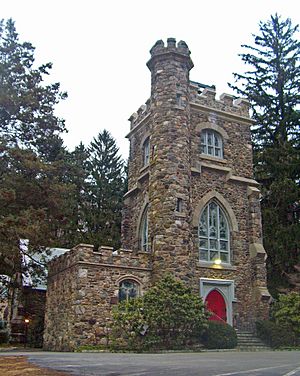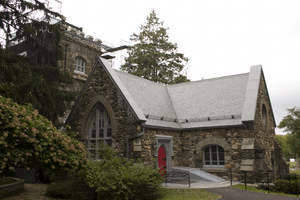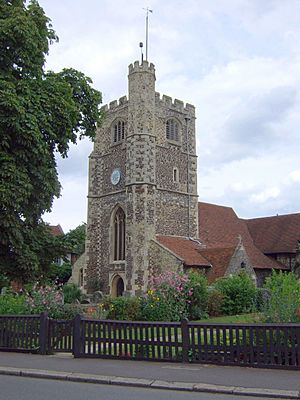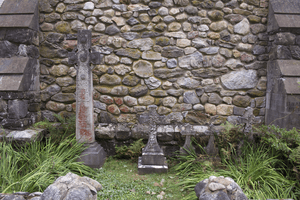Church of Saint Mary the Virgin (Chappaqua, New York) facts for kids
Quick facts for kids Church of Saint Mary the Virgin |
|
|---|---|

West (front) elevation, 2009
|
|
| Religion | |
| Affiliation | Episcopal Church |
| Leadership | Fr. Joel Mason, rector |
| Year consecrated | 1906 |
| Location | |
| Location | Chappaqua, NY, USA |
| Architecture | |
| Architect(s) | Morgan O'Brien. |
| Architectural type | chapel |
| Architectural style | Gothic Revival |
| Groundbreaking | 1904 |
| Completed | 1904 |
| Specifications | |
| Direction of façade | west |
| Materials | stone |
| U.S. National Register of Historic Places | |
| Added to NRHP | April 19, 1979 |
| NRHP Reference no. | 79003213 |
| Website | |
| The Church of Saint Mary the Virgin | |
The Church of Saint Mary the Virgin is an Episcopal church located in Chappaqua, New York, in the United States. It was built in the early 1900s on land given by Gabrielle, the daughter of famous newspaper editor Horace Greeley. Her husband, Frank Clendenin, was also an Episcopal priest.
In 1979, the church and the nearby "Greeley Grove" of trees were added to the National Register of Historic Places. This means they are important historical sites.
Horace Greeley was a well-known editor of the New York Tribune newspaper. He ran for President in 1872 but did not win. He had planted many evergreen trees on his farm 16 years earlier. These trees acted as a windbreak and showed his support for planting new forests and protecting nature.
After the election, Horace Greeley passed away. His daughter Gabrielle inherited his large farm. This farm covered most of what is now downtown Chappaqua.
In 1903, Gabrielle's young daughter, Muriel, died. Gabrielle and her husband, Frank Clendenin, decided to build the church as a special private chapel to remember her. The architect, Morgan O'Brien, designed the stone church in the Gothic Revival style. It looked very much like a 15th-century church in England called Saint Mary the Virgin in Monken Hadley.
Two years later, a beautiful stained glass window from the original English church was given to the Chappaqua church. In 1916, the Clendenins gave the church to the Episcopal Diocese of New York. They had some special rules for the gift. One rule was that they and their children would always be buried in a small plot behind the church. Since then, it has become a regular parish church for the community. The church's yearly Strawberry Festival is now one of Chappaqua's most popular events.
Contents
The Church Building and Its Surroundings
The Church of Saint Mary the Virgin is located just south of downtown Chappaqua. It sits on a 4-acre piece of land on the east side of South Greeley Avenue. This area is flat and is near the beginning of the Saw Mill River. It is surrounded by hills that are common in northern Westchester County.
What's Nearby?
To the north of the church is Robert E. Bell Middle School. Both the church and the school have large lawns in front of them, set back from the street. To the south and east, you'll find Greeley Grove. This grove has many evergreen trees that are over 150 feet tall. These trees help separate the church from the modern Chappaqua library to the east. To the west, the ground rises steeply to homes along Aldridge Road.
Across the street from the church is a baseball field. This open space is between the church and the New Castle town hall. Beyond the baseball field are the parking lots for the Chappaqua train station. This station is on Metro-North Railroad's Harlem Line. The train tracks run next to the Saw Mill River. The old stone station building is also a historic site. It has a statue of Horace Greeley in front of it, as his daughter and son-in-law also gave the land for the station.
Church Design and Features
A driveway from the middle school parking lot leads south to the church. The church building is shaped like a cross, which is called a cruciform plan. It is one and a half stories tall and made of fieldstone, which is natural stone found in fields. The roof is steeply sloped and covered in shingles.
At the front (west) of the church, there is a three-story square tower. This tower has a round, small tower called a turret on its northwest corner. On the north side of the church, there is a small, one-story extension with a flat roof. A separate building called a parish hall, which has a gabled roof with windows sticking out (called dormer windows), is located to the northeast.
The church has stone supports called buttresses at its corners. These buttresses are made of both smooth and rough fieldstone. The main entrance and the back (east) entrance have pointed-arch wooden doors. Stone steps with iron railings lead to the main entrance, surrounded by rhododendrons and other trimmed bushes. The church windows are either round-arched or pointed-arched, with smooth stone sills and tops. The east end of the church has a single round window called an oculus. At the roofline, a low wall called a parapet marks the edge of the roof.
On the tower, the buttresses go up two stories to a stone ledge called a cornice. This ledge separates the two main parts of the tower. Above that, another cornice sets off the battlements, which are the notched walls at the top, like on a castle. The turret has two narrow windows and is also topped with battlements. The extension on the north wall also has battlements.
History of the Church
Chappaqua was first settled by Quakers in the early 1700s. It was a small farming town centered around its meetinghouse. This meetinghouse is now part of the historic district north of downtown. When the New York and Harlem Railroad was built through the area in the mid-1800s, things changed. Farmers could now sell their crops in New York City, and people from the city started moving to Chappaqua.
Horace Greeley's Influence
Horace Greeley, the editor of the New York Tribune, was one of the first people to move there from the city. He wanted to escape his busy city life and give his family a quiet country home. He also wanted to try out new farming methods he wrote about in his newspaper. One of these ideas was planting the grove of trees. This grove was not only beautiful but also showed his support for protecting nature and planting new forests. By 1872, the grove was so large that he held a big party there to support his run for president.
He lost the election to Ulysses S. Grant. Horace Greeley passed away after the election but before the final votes were counted. His daughter Gabrielle inherited the family farm, which was about 100 acres in what is now downtown Chappaqua.
Later, Gabrielle and her husband, Frank Clendenin, who was a priest at St. Peter's Episcopal Church in New York City, started dividing up the land. In 1903, their five-year-old daughter, Muriel, died from polio. To honor her, they decided to build a memorial chapel next to the grove of trees Horace Greeley had planted.
Architect Morgan O'Brien designed the church in the Gothic Revival style. It was a close copy of the Saint Mary the Virgin Church, which was built in 1494 in Monken Hadley, England. The Chappaqua church was finished in 1904 and officially opened in 1906. A stained glass window from the English church was given to the new church and is now in its north transept.
Becoming a Parish Church
In 1913, the church became a "mission church" of the Episcopal Diocese of New York. Three years later, the Clendenins officially gave the 4-acre property to the Diocese. They had several important rules:
- The church must always be free to use.
- It must always be named Saint Mary the Virgin.
- No mortgage or other financial burden could be placed on the property.
- The family would keep the right to a 20-by-12-foot burial plot behind the church.
If the diocese ever broke any of these rules, the ownership of the church would go back to the Clendenins or their living family members. These rules are still in place today.
In 1919, a furnace in the basement caused a fire that damaged the inside of the church. After the fire, some changes were made. Large screens and a canopy (called a baldachin) that had separated parts of the church were not replaced. Instead, a large pulpit was put in, along with altar rails and prayer stalls around the sanctuary. In 1924, a set of 10 bells, called a carillon, was added to the tower. These bells ring out the Westminster Chimes every 15 minutes.
Frank Clendenin retired from St. Peter's in 1917. Another daughter, Gabrielle Clendenin Stahl, passed away in 1920. The family continued to worship at the church they built until their deaths in the 1930s. The Clendenins and all four of their children are buried in the small plot they arranged for, as per their agreement with the diocese. Later in the 1930s, the pulpit that was installed after the 1919 fire was removed.
In 1938, the church's women's group started the first Strawberry Festival. This festival has been held every year since then. It has many activities for children, including rides and walks through Greeley Grove. The next year, they started a social event for adults called the Black Tie Dance, which also became a yearly tradition.
In 1943, the church officially became a parish, which means it became a self-governing church. The following year, it was accepted into the diocese. The new parish took over the ownership of the property in 1949, but the Clendenins' rules still applied.
As the only Episcopal church in Chappaqua, Saint Mary's needed to serve its growing community. Construction began on the parish hall in the 1950s. The first floor was finished in 1951, and the whole building was complete three years later. In 1955, a baptistry, which is a place for baptisms, was installed. It was copied from the original church in Monken Hadley and made in England.
The church building itself stayed mostly the same, except for a new organ in the mid-1960s, until 1982. That year, renovations in the sanctuary removed the altar rails and prayer stalls that had been put in after the 1919 fire. The stone altar was replaced with a new altar that could be moved. The old stone altar was moved outside to the hillside.
Church Activities and Events
The Church of Saint Mary the Virgin offers two services on Sunday mornings. The Holy Eucharist (Communion) is held at an earlier time using one style of service (Rite I) and at a later time using another style (Rite II). Many church members who are not priests help the pastor, Father Joel Mason, with these services.
Music Programs
The church also has a strong music program. An adult choir sings at the later Sunday morning service every week. They also sing daily during Holy Week (the week before Easter) and four times a year during evening services called Evensong. Their music mainly focuses on traditional Anglican music, but they also perform modern pieces by composers like Igor Stravinsky and John Tavener. A children's choir sings at services once a month. Besides religious music, the church also hosts "Ars Antiqua" concerts three times a year, which feature non-religious music.
The Strawberry Festival
Every June, the church holds its yearly Strawberry Festival. This festival is thought to be the longest-running community event of its kind in Westchester County. People come from all over the county to enjoy it. The main attraction is food made by church members using strawberries. This includes strawberry shortcake, strawberry pancakes, chocolate-covered strawberries, and strawberry smoothies.
Other fun summer festival foods are also available, like ice cream donated by Ben & Jerry's, hot dogs, hamburgers, popcorn, and cotton candy. Craft sellers offer handmade textile and wooden items. There are also fun activities for children, such as bouncy houses, pony rides in the Grove, and face painting. The money raised from the festival helps support the church's involvement in local charity programs, like food pantries.
See also
- List of Episcopal churches
- National Register of Historic Places listings in northern Westchester County, New York




